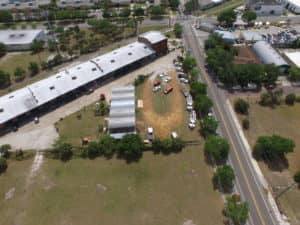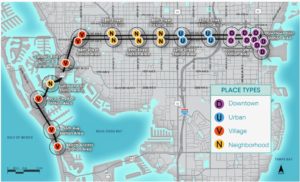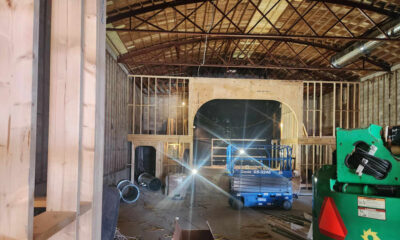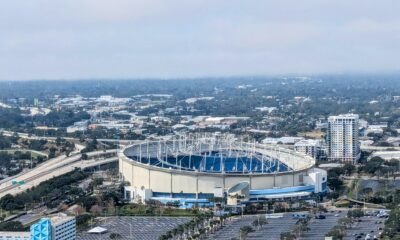Place
St. Petersburg to make ‘bold’ zoning changes

In an emphatic show of solidarity, the St. Petersburg City Council, business leaders and residents all unanimously expressed their support for changing zoning laws and land development regulations along the city’s SunRunner route.
During Thursday’s meeting, members of the city council heard a resolution to accept the results of the SunRunner Rising Development Study that establishes an implementation strategy for transit-supported development and infrastructure along the 10-mile bus rapid transit (BRT) line. The $44 million project is the first BRT in Tampa Bay, and the Pinellas Suncoast Transit Authority (PSTA) expects it to launch in August.
While the SunRunner will run through St. Petersburg to St. Pete Beach, the discussion focused on zoning and regulations around station areas on 1st Avenue North and South. Specifically on transforming industrially zoned and perpetually underused land near the 22nd Street South Corridor into mixed zoning to spur growth. Not only were the various stakeholders ardent in their support for the changes, but they also emphasized the need for urgency.
“It’s really an important and exciting time in our city, and I urge you to move quickly,” said Jason Mathis, CEO of the St. Petersburg Downtown Partnership. “Now is the time to be bold and move forward aggressively with zoning that will suit the needs of our changing city.”
In 2019, Miami-based developer Joe Furst purchased over seven acres of underutilized land between 3rd and 5th Avenues, along 22nd Street. In March, he told the Catalyst that he read the Deuces Live and Warehouse Arts District’s recently created action plan and found it compelling. Since then, Furst has spearheaded an industrial mixed-use rezoning initiative in the area, I-Mix.

An aerial view of the site that Joe Furst hopes to transform from vacant industrial land to a mixed-use development. The Morean Center for Clay, located in the old train depot, is at the top. Photo provided.
Furst followed Mathis during the public forum session of the discussion and began by stating his community engagement with the Deuces Live and local business and property owners, all of which support the changes. He said that while he appreciated the PSTA planning committee’s work, only allowing zoning changes within a quarter-mile of SunRunner stations “doesn’t make any sense” when a multimodal street and the Pinellas Trail buffer the area.
“Why are we reducing density and intensity when you have the single greatest underutilized public asset in the city?” asked Furst. “The density along the trail should be absolutely as intense as the density is right next to the station area.
“You’re talking about a total distance of 1,250 feet from the Pinellas Trail to the station area on 22nd Street South – why on earth would we limit the intensity at that moment?
City Council agreed with Mathis, Furst and the other business and property owners that spoke during the public forum.
Councilmember Brandi Gabbard said she was happy to finally have a resolution following several committee processes and studies. She also thanked those working to revitalize the historically Black and culturally significant 22nd Street corridor. She then asked Liz Abernethy, director of planning services for the city, to explain the next steps in the process.
Abernethy said there are several different zoning packages related to the city’s implementation of the 2050 plan, and they would come before the city council in the coming months. She added that the goal was to have everything accomplished by the end of the year.
“I don’t know how much more ready we could be to get this work done,” said Gabbard. “I want us to be expedient from this point forward.”
Gabbard also asked if the quarter-mile radius for zoning changes was “set in stone,” and Abernethy assured her it was not.
Councilmember Deborah Figgs-Sanders said that when she hears a project is vital, she wants to ensure that vitality includes opportunities for everyone. She said she appreciates those that attended the meeting and supports the resolution but wants to ensure no one gets left out of the process.
“Let us be mindful in moving forward,” she cautioned. “We don’t want our forward movements to send anybody backward.”
Council Chair Gina Driscoll began her remarks by succinctly stating that “it’s time for us to respond.”

A map showing the proposed SunRunner route. PSTA officials expect it to launch later this year. Screengrab.
Driscoll then noted the current resolution was just to accept the study and consider the recommendations but said she wanted to go further.
Driscoll said she wanted to make specific requests for 22nd Street to ensure that the zoning changes extend throughout the surrounding area. She added that while other proposed zoning changes throughout the city were also important, she would like to prioritize the initiative around the Deuces Live and Warehouse Arts Districts.
Councilmember Ed Montanari agreed with his colleagues and said city officials need to move aggressively forward on the issue. He explained that once the SunRunner is operational, it will take years to create development along the route. That makes establishing the proper zoning now imperative.
“So, I hope the staff has heard us loud and clear on this,” said Montanari. “I’m ready to move forward right now.”
Abernethy said she would provide the city council with an update on the proposed zoning changes during a May 26 Committee of the Whole meeting. Council unanimously approved the results of the SunRunner Rising Development Study.








Bill Kirkpatrick
April 27, 2022at3:35 pm
Joe got the right idea, we gotta strip most Bay Area zoning laws to their bones and really audit how much they are harming our communities. Do I love that a phosphate factory can’t open up next door? Yes absolutely, seems pretty good. Do I like that we can’t have corner store, mixed use buildings, or multifamily housing in most of the bay area? No not even a little, it’s suffocating our community.
Speaking of suffocating, there’s alot of nimby, boomer, “I got lead poisoning from driving when I was 12 after the war” energy in here. People use whatever form of transportation is most convenient. Turns out a lot of people got rich making sure that was driving your car Karen. Those same people invested in making sure public transportation was both inconvenient (and not just because you had to walk a whole block John) and unappealing. Investing in making busing convenient, fast, and comfortable means people will have an incentive to not pay 40 bucks to get in an Uber. This seems like a good first step towards two very important thing that need to change in the Bay Area, now if Tampa could just build more protected bike lanes …
Joe Gray
April 24, 2022at3:38 pm
While the city keeps just talking about things that will help the South side of St Pete (while nothing is actually happening), high rises, condos and 300+ apartments unit complexes are somehow being allowed to be built all over ares with “N” at the end of their street address.
If this zoning law can be changed for a VERY wealthy Miami developer on the South Side RAPIDLY, why stop there? Why not allow zoning changes to allow duplexes and quad homes to be built on all the EMPTY LOTS ALL OVER THE SOUTH SIDE!!! Have you seen how many empty lots could be homes in the south side? Allowing duplexes and tri/quad homes would explode development.
Why only do this one area, benefitting mostly this one Miami millionaire? If the zoning changes allowed duplexes to be built on empty lots, construction would BEGIN THE NEXT DAY!
CHANGE ALL THE ZONING LAWS IN ST PETE FOR ALL. NOT JUST WEALTHY DEVELOPERS!
Roy Glass
April 23, 2022at5:04 pm
Karen for Air-conditioned Buses, it’s hot and muggy Summer! Problem solved and I agree.
Anon
April 23, 2022at4:42 pm
Scratch all of that and make more bus routes available, more buses, and have them available day and night. That’s how they do it in Europe.
Karen Phinney Kirkpatrick
April 23, 2022at4:19 pm
I do feel I am throwing cold water on a hot topic. I apologize in advance for being a Negative Nancy. However, I have lived in Pinellas County for almost 30 years now, the last 20 in St. Petersburg and 80% of this time I have not owned a car. I have been an extremely frequent rider of PSTA. The hospitality industry brought me to Florida and I have marketing experience. With the advent of ride sharing services coupled with the Florida heat, this project is dead in the water. People simply will NOT ride a city bus unless they have to. If you don’t believe me, please try riding one. Go ahead and continue to throw millions of taxpayers dollars at these projects without even riding buses yourselves to understand why not.
Shirley Hayes
April 22, 2022at9:13 pm
Mr. Donovan, I hope that you are wrong also. It could reduce the number of cars downtown and increase foot traffic of beach residents. This could be good for businesses downtown. Now let’s see the bus schedule????
John Donovan
April 22, 2022at5:33 pm
In my estimation, the SunRunner bus system itself probably has a 50% likelihood of being an economic failure. IOW -it will lose money regularly. The lack of a two-way route on the same street in St Petersburg makes one station ‘close”, the return trip station “far” (the distance between 1st Ave N & South, and stations). That’s less than ideal design. An improvement would be a Tropicana Field short route. All that said, higher density near core transportation routes makes sense regardless. PS – I hope I’m wrong about SunRunner being an economic or practical failure.